Like a musician, I like to "riff" on things---namely, shapes or colors that are already on the paper. I sometimes drag a brush loaded with acrylic paint across paper and create directional drybrush lines. Then, I look at the paper to see if I can build subject matter on top (as in my painting "Burgundy Pants" below).
|
Although I've read that there ARE no accidents in art, I beg to differ. Quite often, I go into my home studio, pick up a paintbrush and begin creating paintings that surprise me and probably can't be replicated again (at least, not by me). Like a musician, I like to "riff" on things---namely, shapes or colors that are already on the paper. I sometimes drag a brush loaded with acrylic paint across paper and create directional drybrush lines. Then, I look at the paper to see if I can build subject matter on top (as in my painting "Burgundy Pants" below). Other times, I marble over an old watercolor painting, and then once it's dry, I take it into the studio and react to what is there on the paper by extending a line, a shape, a color, or opaquely painting OVER much of the marbled pattern. I never know what odd figures are going to emerge from these sessions but in the case of "Unbroken Bonds #1" (below), I ended up with pointy headed figures. I have no idea where this idea came from, but I rather like it. When I work in this way, I'm not worrying about the outcome, and I give myself the freedom to play. Because of this, I often end up with a spontaneous painting that I had no idea I could make! It's a good reminder that I don't need to aim to create a "masterpiece" (as if I could wish that into existence); I just need to show up, get to work, and see what happens.
0 Comments
Our modern environment has conditioned us to move quickly and buy or get things NOW. While I admit to falling prey to clever advertising ploys from time to time, my life as an artist has shown me that faster is not always better when it comes to finishing a painting. A now-famous 1972 Stanford marshmallow experiment was a study on delayed gratification led by psychologist Walter Mischel, a Stanford University professor. In this study, a child was offered a choice between one small but immediate reward, or two small rewards if they waited for a period of time. During this time, the researcher left the child in a room with a single marshmallow for about 15 minutes and then returned. If the child did not eat the marshmallow, the reward was another treat of their preference. In follow-up studies, the researchers found that children who were able to wait longer for the preferred rewards tended to have better life outcomes, as measured by SAT scores, educational attainment, and other life measures. (It must be noted that this study was somewhat debunked because it turns out that one's economic background, rather than willpower, has more to do with a positive life outcome). All of this is to say that I've learned over the years that just because I WANT a painting to be done, doesn't make it so. It's not even about being a perfectionist or a procrastinator--it's that my standards are a lot higher than they used to be because when I KNOW better, I DO better (as the saying goes). Such is the case of my painting "Winds Of Change" which I began in 2021 and finally finished last week! It went through many iterations--mostly having to do with the upper right quadrant of the painting (the figure's hair and the circle behind her). It languished for months as I worked on other paintings, but I kept coming back to it to try and figure out what was wrong/missing and how to correct it. I finally showed the painting to a critique group this fall, and someone mentioned that the figure was so strong and full of movement, the hair needed to match that intensity of color and flow. (Why didn't I think of that?). There was no way I was going to attempt to hand-paint strokes of color in her hair, so I decided to try to find collage paper that would do the trick. I looked through my hand marbled papers to find a pattern/color that would fit with the rest of the painting (not an easy task). Lucky for me, I save all sorts of marbled paper scraps, and I found the perfect one! I cut out a tracing paper template of the hair shape and used that to cut out the paper so it would fit perfectly over the existing hair. I taped it in place and photographed the piece to see if it looked right. It did! Then I carefully glued it into place and after it was dry, I photographed the finished painting. My patience (and ability to heed a valid criticism of my painting) paid off. Two years after I started it, "Winds of Change" is now finally complete (and no marshmallows were involved!). It has been a busy spring/summer/fall but I'm finally turning my attention to my web blog. Most of the time, I let my paintings doing the talking, but every now and then, I get the urge to put things down in writing. Our only daughter, Saran, had been living in the Bay area since 2016 working as a writer for a mobile game company. In September, she accepted a job offer as Story Director at a gaming company in Copenhagen Denmark. Saran agreed to move abroad (telecommuting was not an option) and spent a month preparing for her departure. She drove her car to Oregon where we live, and we helped her pack up 13 boxes of her possessions (she sold or gave away furniture, household goods, and anything that she didn't want to ship). It was quite the process, and I marveled at how she was able to distill her life down to so few boxes. (When I was 30, I had so many boxes of LPs, photos, books, etc. I could have filled a whole room!). We put Saran on a plane, and poof--she was on the other side of the world! Luckily, free apps help keep us connected via videochat and text; so far, she seems to be thriving in her new environment. My husband wrote this on his facebook page the day he drove Saran to the airport: Dropped off my daughter at the airport, as she is moving to Copenhagen, Denmark, for work. Every child's departure asks more urgently than the last in a parent's soul "Will I see you again? When?" For us, the first departure was college. Her college was an hour away, far enough for her to have to fend for herself, close enough we could help if the need were to arise. The next one was to graduate school in Edinburgh, Scotland. Farther yet afield, but for only a year; how much could happen in a year? We never thought of this as something permanent; she developed a love for Edinburgh, but, with school finished, she returned home. The next one was getting her first job in California. This was farther, but still only a couple of hours by plane. Out of sight but not out of mind, and close enough that we could help if needed. But to another country, half way round the Earth? That seems more irreversible, more decisive. My imagination cannot paint what lies ahead, because living elsewhere is beyond my experience. Of course we never can see what lies beyond today, but even in our hectic age our world changes; it changes so slowly we construct the illusion that tomorrow will be like today. Until it isn't. It never is the same today as it was yesterday. These departures bring our lives into clearer focus. Ride the wind, little bird, where ever it might blow you. All of this is to say that everything changes--in art as well as in life--and we have to learn to adapt and let go of some of our long-held beliefs and assumptions. Days after Saran left for Denmark, I taught an in-person two day weekend mixed media workshop here in Portland, and had to adjust my approach to meet the needs of the students (who ranged from experienced artists to novice beginners). It was a big leap from the relative control I've enjoyed when I teach via ZOOM these past few years, but I rose to the challenge and we had a successful workshop. There were equipment snafus (I wasn't able to connect my laptop to the projector) but we sailed through it and the students and I created some interesting paintings (some of which I've included in this post). Artists love to paint--it's what we do best. If, like me, you paint most of your works on watercolor or printmaking paper, the next step after finishing your painting is to decide how to present it for display. If you have just one painting to prepare for a competition or exhibit, you might take it to your local frame shop and let them professionally mat and frame the painting. But that can be expensive (and even cost prohibitive) if you're mounting a solo show of 15+ paintings, so I've learned how to mat/frame my artwork and I've even documented the process for my students. It's not easy, but it's a skill that can be acquired with a bit of practice and the right materials. One thing that's made a big difference for me is that I plan my painting size in advance so that I know my painting will fit into a particular size of mat and frame. (No oddball sizes!). This allows me to remove paintings from frames, and put a new painting in the same frame or mat. Recycle, reuse! As you can see from the Framing Matting Sizes For Artwork.pdf document at the end of this blog post, I use a limited number of sizes for my works on paper and I rarely deviate from those dimensions. That saves me money and time. Next, I've gotten to the point in my life where cutting matboard with a mat cutter is too much of a strain on my hands, so I order custom cut mats in bulk (it reduces the price dramatically!) from a website called www.matboardandmore. They ship the mats in sturdy boxes and I keep the mats boxed up and protected in my garage. They also carry foamcore backing board cut to the size of your mat (much easier than buying a huge foamcore board and trying to cut it yourself--something I used to do but don't anymore). I favor a single 4 ply off white (or white) mat because most shows I enter request this type of mat, and it's easy to order this in bulk. I favor black matte (not shiny) metal frames which I order from www.americanframe.com. This company makes a good product, and ships the frame sections in plastic sleeves with size printed on an attached label, and includes a frame kit for assembling the frame so that all you need is a screwdriver. Why do I favor matte black metal frames, you ask? It's simple--when you have to put together a big solo show (as I'm currently doing) it's best to have your frames present a unified front! As always, one must read a show's prospectus--there are organizations that insist on non-metal frames (which puts an additional cost burden on the artist, who may have to take the painting to a frame shop). I used to order my plexiglass from American Frame but shipping has gotten expensive for bulky items, so I was happy to discover Tap Plastics https://www.tapplastics.com/ which has a local store in Portland, Oregon, where I live. I can call ahead and place an order over the phone for whatever size I need of their 1/8" acrylic plexiglass and pick it up the next day. Plexiglass scratches easily, so they apply a thin plastic film on both sides of the plexi which you keep in place until you are ready to assemble your frame--it peels off with very little effort. I often order extra sheets of plexi in the sizes I frequent use because sometimes my painting comes back from a show with scratch on it, rendering it unusable for future paintings. The other items you'll need to put the painting together in the frame are linen hinge tape (instructions for using this are in the Framing Made Simple by Ellen Fountain .pdf I've attached) and plastic coated hanging wire (I put a link in the Framing For American Frame .pdf). And of course a screwdriver--I have an electric one with interchangeable flat/phillip heads. Automation is our friend! I hope this post gives artists the courage to do a little DIY matting and framing. Here's another tip: Don't feel you have to do it ALL by yourself. When I recently needed to assemble 14 paintings in their frames for an upcoming solo show, I hired a 30 year old helper (the son of an artist friend) to come over and assist me with the task. It took the two of us working together about 3 hours to assemble 14 paintings. (I had previously taped the paintings to the mats and ordered all the right sizes of plexiglass and metal frames, so I was organized and ready!). This young man hadn't framed paintings before, but after I demonstrated the process (and stayed nearby to help with any questions) he got the hang of it. 20 years ago, I could have easily done this task myself, but I'm learning that hiring an extra pair of hands is money well spent. It's still less expensive than farming the whole thing out to a frame shop.
In April, I gave a talk to the Watercolor Society of Oregon entitled "Is It Finished?". My digital slideshow was full of before and after images by artists who'd given me permission to share their work with the group. Naturally, I included many of my images, too, and one of my favorite examples is my painting "Backbeat #1" (acrylic on paper, 10 x 14"). "Backbeat" began like a lot of my paintings do---by applying acrylic paint to paper using a sponge roller. Then I add a bit more paint and start to see something take shape. In this case it was a figure, but it wasn't clear what kind of figure. The drummer came from a suggestion a fellow artist made during a critique session. Something about the shapes suggested a drum kit, so I delved into that idea with gusto. But I struggled along the way with color and how much detail to include. I've included a progression slideshow of "Backbeat" below. Once I made my final corrections, I knew the painting was complete. This piece won an Award of Distinction in the WSO Spring Show in Bend, Oregon from juror Vera Dickerson. The end of 2022 is fast approaching and many of us ask ourselves "where did the time go?". Those of us who are lucky enough to call ourselves artists (or more accurately, "people who make art") can point to the work we've created during the year and know that we've been measurably productive. Results may vary, since larger works may take an artist months to finish while artists like me (who work on paper in smaller sizes) can end up with a pile of paintings that number in the triple digits! In my defense, I've been painting over a lot of my lesser works, and delighting in the many complex layers I've created in my recent paintings. Each year, I take stock of what I consider to be my "best of" paintings. This evaluation process helps me decide on what series I want to continue to work on, what I want to do less of, and where I ultimately want to focus my time and energy. To that end, I create a file folder on my PC, and drag images into that folder that I think were important to my artistic development. These images run the gamut from successful show paintings/award winners to humble experiments that didn't quite click, but still moved me in a new direction. I print out little thumbnail images, paste them into a notebook, and write a few sentences about *why* a particular painting is important to me, and what I learned from making it. It's a kind of personal "greatest hits" but it's also a distillation/concentration of where I'm at in my life and how that's reflected in the art I create. One thing that moved me in a new artistic direction was rather unexpected. This past February, a friend told me about a free ZOOM mini course taught by CA artist/art coach Nancy Hillis. On a whim, I signed up. Hillis favors an abstract gestural style of painting and her mantra (which I embraced) is "surprise yourself every day in your studio". That one directive stuck with me. For a month, I dribbled acrylic inks over old paintings, and let things RUN amok! The results were, indeed, surprising and unlocked a new path for me: creating non-representational paintings! I started using this method whenever I got stuck or hung up on a painting that wasn't working, and I ended up with some surprisingly effective results. Here's just one example of how I used this method to fix a painting that wasn't working. The painting on the left contained a figure that I wasn't particularly fond of (the head/hair wasn't quite right) but I still loved the yellow and green colors and knew I could capitalize on that. Once I started applying black acrylic ink with a brush, and adding some mid-tone purple, I was in the groove! I ended up with what I feel is a nice variety of shapes and harmonious colors in this small 11 x 14" painting "Down the Garden Path". At no point was I afraid of "ruining" this painting because I figured had nowhere to go but up! I've embraced that philosophy for the past decade or so, and it's resulted in some revived-from-the-dead paintings that exceeded all expectations and even SURPRISED ME! As I wrap things up for the current year, I am also gearing up for 2023. I have earmarked paintings for entry into national and regional exhibitions with January deadlines, done an inventory on my frames and mats, started planning for my solo exhibit at the Coos Art Museum in Coos Bay, Oregon in October, and organized materials for the ZOOM workshop I'm teaching in February.
All of these tasks are part of being an artist; they add rhythm and structure to my days, and keep me actively involved in the greater art community--for which I am extremely grateful. I never get tired of looking at the jumble of colors, shapes, and marks on my painted or marbled papers as I try to coax out the subject matter hiding within. A woman who purchased one of my marbled paintings remarked "You are so good at pulling secrets out of paper!" which seems like the perfect way to describe my process. Recently, I tried something really wild and crazy while dropping acrylic colors into my marbling tray (to later be transferred onto my paper). Using an eyedropper, I carefully applied color to the tray in a swift, circular fashion, creating a kind of "ring" of colors (black on the outermost edge, and then white, and some teal). Needless to say, the resulting paper was pretty wild--even by my standards. Later, when I assessed the papers I'd marbled that day, this odd ball "nucleus" pattern baffled me. What was I going to do with this strange pattern? Add more circles or ovals? Paint over parts of it? I tried many things---stenciling on part of it, covering places with darker tones, but I had NO IDEA what the end result would be. And I was OK with that, because I love the challenge of not knowing where my painting is headed. I figure it'll all work out in the end (and it usually does). I let the painting sit for a day or so and then went back to it and did something that helps me forge ahead when I'm stuck: I turned the paper in different directions to see if some idea jumped out at me, and fairly soon, I sketched a woman in a wide skirt (one of my tried and true favorite subjects). Now it was just a matter of painting the space around her so she would "pop" and be more noticeable. I'm not quite done with this painting yet, and I don't have a title (that always comes at the VERY END) but I like the direction of this piece. It was a hard-won struggle, but I rose to the challenge! When I create acrylic marbled papers, I often produce "dud" papers that are too pale, or uninteresting, or otherwise uninspiring to me. I save these in a big pile in my garage, and when I'm in the mood to repurpose them I sometimes marble these papers a SECOND time. This practice of overmarbling can lead to some interesting patterns (or, in some cases, a muddled mess!). The trick is overmarble big patterns onto small ones, or circular patterns onto stripes. In this case, I had a beautiful overmarbled paper (on 140# cold press watercolor paper) that I thought I could perhaps turn into a painting. The circular marbling (a modified "tiger's eye" pattern) looked, to me, like hydrangea flowers, so I thought I'd try that idea. I drew the vase and outline shapes of the flowers using water soluble crayon but everything was the same general color and value. Using acrylics, I painted teal in the background but that was too solid and boring, so after that dried, I used thin automotive detailing tape and applied it in striped formation on the teal. Then using a foam roller with off white acrylic paint on it, I lightly went over the teal section and then I pulled off the thin tape. It left a nice striped pattern in the background. I had some stenciled collage paper (on thin deli wrap) that I cut out for the tablecloth underneath the vase. I used a white acrylic fine tip pen to scribble a pattern all over the flower heads. But the overall shape of the flowers seemed awkward and I realized I wouldn't be able to easily fix it since I'd covered up so much of the marbling with acrylic paint. I set it aside and then the next day, I went for broke and started dribbling paint and water spray on the painting, thinking I'd make it into an abstract piece. But then I turned it horizontally and realized I could salvage a smaller bunch of flowers and shape it differently. I painted aqua onto the vase, glazed the hydrangea heads with orange acrylic (not a typical hydrangea color, but I've seen it) and then added a bit of collage paper on the middle/upper left of the painting to tie it to the collage paper on the right hand side. Not bad for a painting I was about to give up on! By turning it, I was able to look at it another way and realize I could still create a vase of hydrangeas---different from my original vision. "Hydrangeas in Vase"; acrylic marbling on paper, 12 x 18". Most artists are good at starting a painting and getting it about 90% done. The hardest part of finishing a painting is that last 10%. Those finishing touches can make all the difference, and take a painting from GOOD to GREAT.
I used to tell myself that a painting was done when I was tired of messing with it, but in reality, I lacked the expertise to TELL whether or not my painting was complete. Some of these paintings got into local shows, but many did not. These "almost finished" paintings languished in my garage until years later when I unearthed them, and examined them from a more experienced perspective. Suddenly, I knew what the paintings needed! In many cases, they lacked dark and light values, a good variety of shapes, soft and hard edges, or CONTRAST (one of my favorites). I'm proud to say that I've shortened the length of time that a painting languishes in the "almost finished" stage before I can call it DONE! These days it only takes me a few weeks or months (instead of years) before I figure out how to put those last important touches on my painting. I'm grateful to members of my trusted critique group for helping me take second look at my paintings to make sure there's nothing further I need to add or take away. It's not about being "picky" or perfectionist, but rather about making the painting the best it can be. In the end, I want viewers to focus on the story of the painting, and not the mechanics or techniques I used to create it. I first painted "Determination #1" (acrylic on paper, 11 x 17") last year and I THOUGHT it was finished. I entered it in a few shows, but it was not selected by any juror and I couldn't quite figure out why. A few months later, I showed it to my trusted critique group and they made a few suggestions for improving this painting. I followed some, but not all, of their advice but the tiny corrections made all the difference. "Determination #1" was one of 95 paintings chosen by juror Linda Daly Baker from 591 submissions for the 42nd Annual San Diego Watercolor Society International Exhibit. If you look at the before and after images, you'll see 2 small but important changes. First, the black sweater was at a diagonal and formed a point where it met the green in the background. To correct this visual tangent, I overpainted the skirt and shortened/straightened the sweater. I had to sacrifice the transparency of the green skirt by adding opaques, but I think it was the right decision. I slightly enlarged her left boot so the pointed heel was minimized. Now her feet were properly grounded and her body/stance communicated the story I was trying to tell. Those 15 minutes of additional brushstrokes were well worth my time! It is March of 2022 and I haven't made time to write a blog this year, so I'll remedy that now. For the past 20 years or so, I've been painting my version of the human form (made up from my imagination most of the time), and I love this subject matter more than any other (even birds, which I paint a lot of!). Lately, though, I've been shaking things up a bit by working on a new series of abstract, non-representational paintings. It all began in February when I attended a ZOOM lecture by artist Nancy Hillis in which she encouraged artists to "surprise yourself" every time you begin/create a painting. It was an "ah-hah" moment for me because I'd gotten into a bit of rut with my work--resolving each painting in a similar way. Boredom was looming on the horizon, so her online lecture was just the motivation I needed to change my approach. I adopted a "what have I got to lose?" attitude and pulled out all the half-baked paintings that were lying around my studio (we're talking double digits here). I realized that however much I stared at these paintings (many of them were started 6 months ago) I had lost interest in finishing them in my usual manner. So I did what Nancy had suggested: I surprised myself! I found my stash of Daler Rowney acrylic inks (in little glass bottles with droppers) and started dripping, spraying, and generally working without a paintbrush in hand to rework these old paintings and transform them into something completely different---abstracts! I must have done a dozen of these in a day---filled with joy at the many possibilities in store, I squeezed out ink, sprayed with water, and let things run and blend on my paper. I followed Nancy's advice: don't judge or assess the work right away, but rather, let the painting sit and then revisit it later. One by one, I set to work on each painting and by the end of day, I was tired but happy---I had repurposed all of these "dud" paintings and surprised myself in the process. I used this new approach for a month, and though I have gone back to painting my figurative works, my approach to HOW I paint and resolve each painting has become more free and open-ended. Progression Slideshow: "Let The Light In #1"; acrylic inks on paper, 12 x 18" |
Artist Liz Walker
I'm a painter/art instructor who lives and works in Portland, Oregon. Archives
December 2023
Categories
All
|
||||||||||||||||||
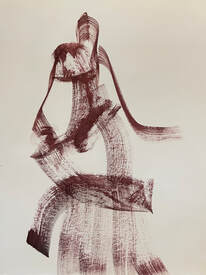

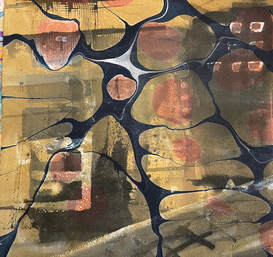
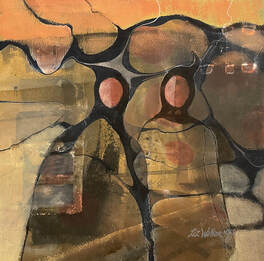
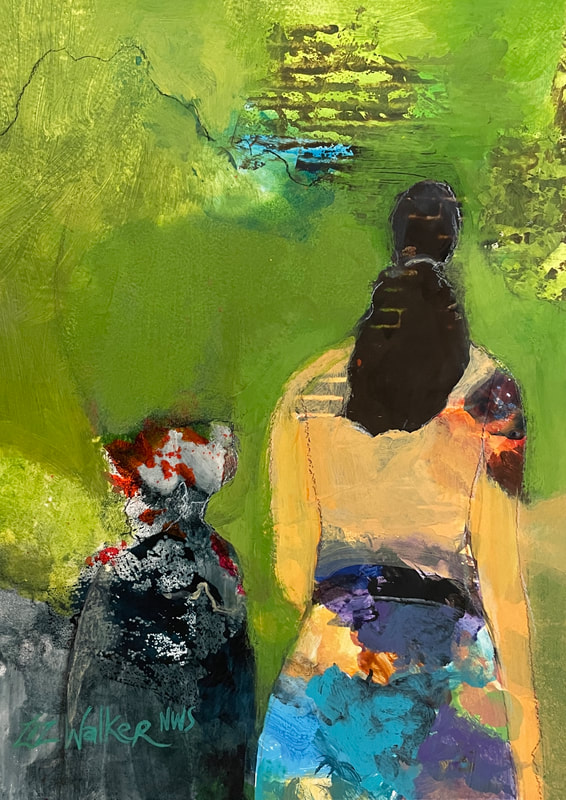
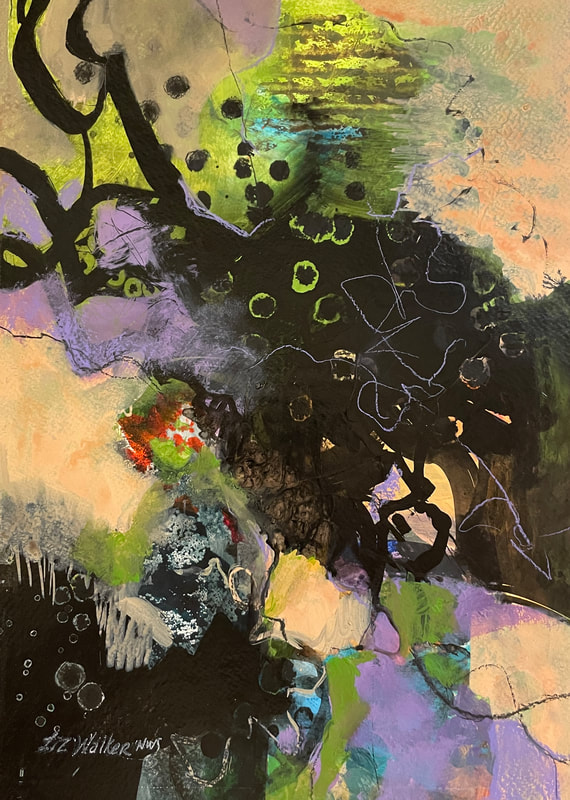
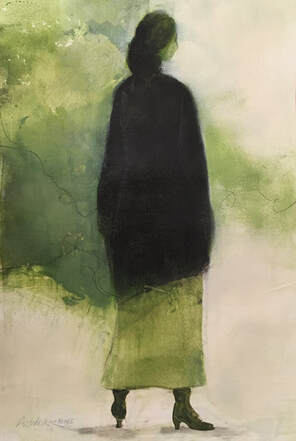
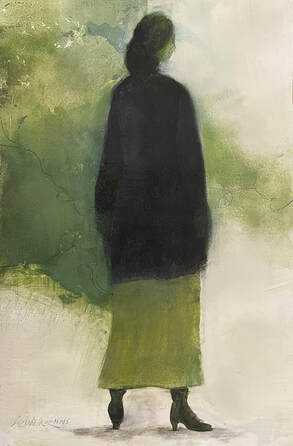
 RSS Feed
RSS Feed